Had a terrific job recently for a dear friend of mine who is the publications director of Villanova Law School. They just built themselves a brand new building. Thank goodness. I shot a few times in the old building and, well, it was tough to find an angle. Let’s leave it at that. The new building has two amazing innovations. Windows and light!
And big common spaces, one of which I needed to show in a picture. Yikes. See below.
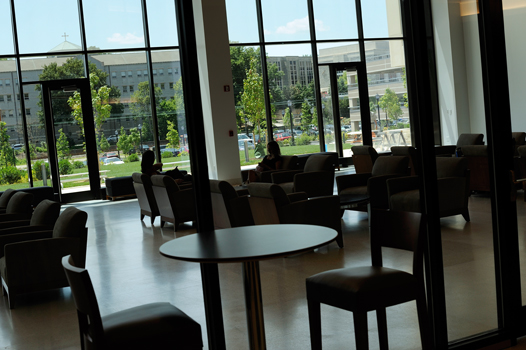
Real big space, lotsa light outside, not too much filtering in naturally, given the angle of the sun. Whaddaya do? I could have drug my shutter and blown the windows, but there goes the detail, some of which speaks to the nature of it being a brand new space. I often advocate mimicking window light by using softeners like bed sheets and the like, and that does produce something very akin to the soft, natural feel of a window. You can do the same thing at the other end of the scale. What would hard daylight do to this room?
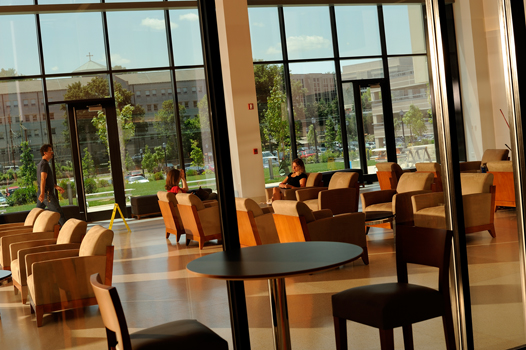
Okay, it’s a starting point. The light in question here is an Elinchrom Digital RX 2400ws unit, gelled warm. Nothing fancy. Just a big, raw light on a stick. Okay, the place is lit, roughly speaking. Time for our wonderful subject.
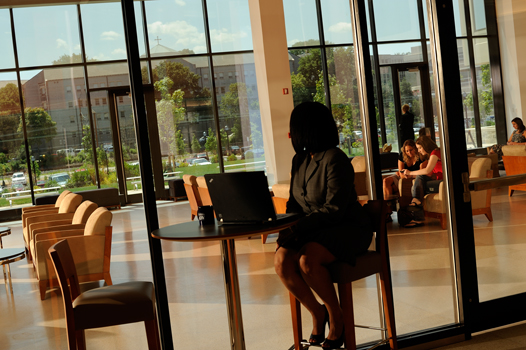
Oops. I had hopes the big light might clip that seated position, and we’d be sorta done, but no such luck. Didn’t want to move the main, cause I had a pillar acting as a big gobo. The pack is cranked to the max, a freight train of light, so that hunk of concrete between the camera and the flash was helpful.
So the mission became to get another light, a key light for my subject, that would resemble the hard feeling of the light in the background, but also be pleasing, and somewhat selective. In other words, not another big light. That woulda turned the whole place into the equivalent of a tanning salon.
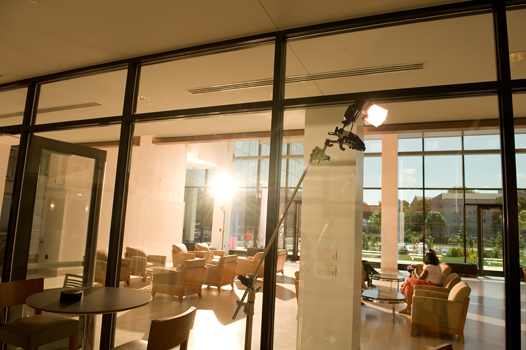
Time for small flash, which you might think would be out of the game, given the monster truck nature of the main, but it fit in perfectly. Flagged it with some gaffer tape to cut spill, zoomed the head to 200mm, gelled it a bit warm, and dialed it into SU-4 mode, so it would simply trip off the big flash, which was in turn triggerred by a Skyport radio trigger. Nice thing about the Skyport when a light is this far away I can not only trigger it, I can adjust power, right from camera. Got this.
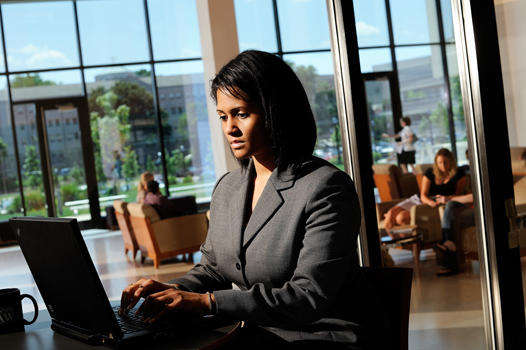
In Capture NX I decided to cool this down slightly. Liked the warm nature of the light, but at the end of the day, given the midday blue of the sky, thought I had stepped on the warm pedal a little too hard. But, the happy, and mildly predictable accident? What can happen when you blow a light into a space indiscriminately, just as the sun might do? Without lifting a finger to the lights, you can get a completely different look to the photo by adjusting lens and position.

This one I let stay warm, cause you only see environment that is dominated by the flash. There’s no other input that would strike an incongruous chord. No umbrellas, no soft boxes. We were done.
Of course, it is tough to come up with all the unpredictable splash and permutations of good old daylight. Late in the afternoon, when the sun actually got to an angle that it saw the interior spaces of the building, I got this, straight up available.

Simple lovely daylight. Who knew? I gotta try this more often! More tk….
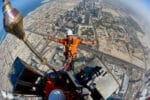
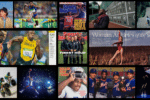
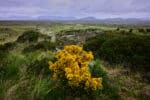
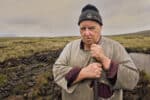
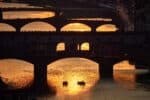
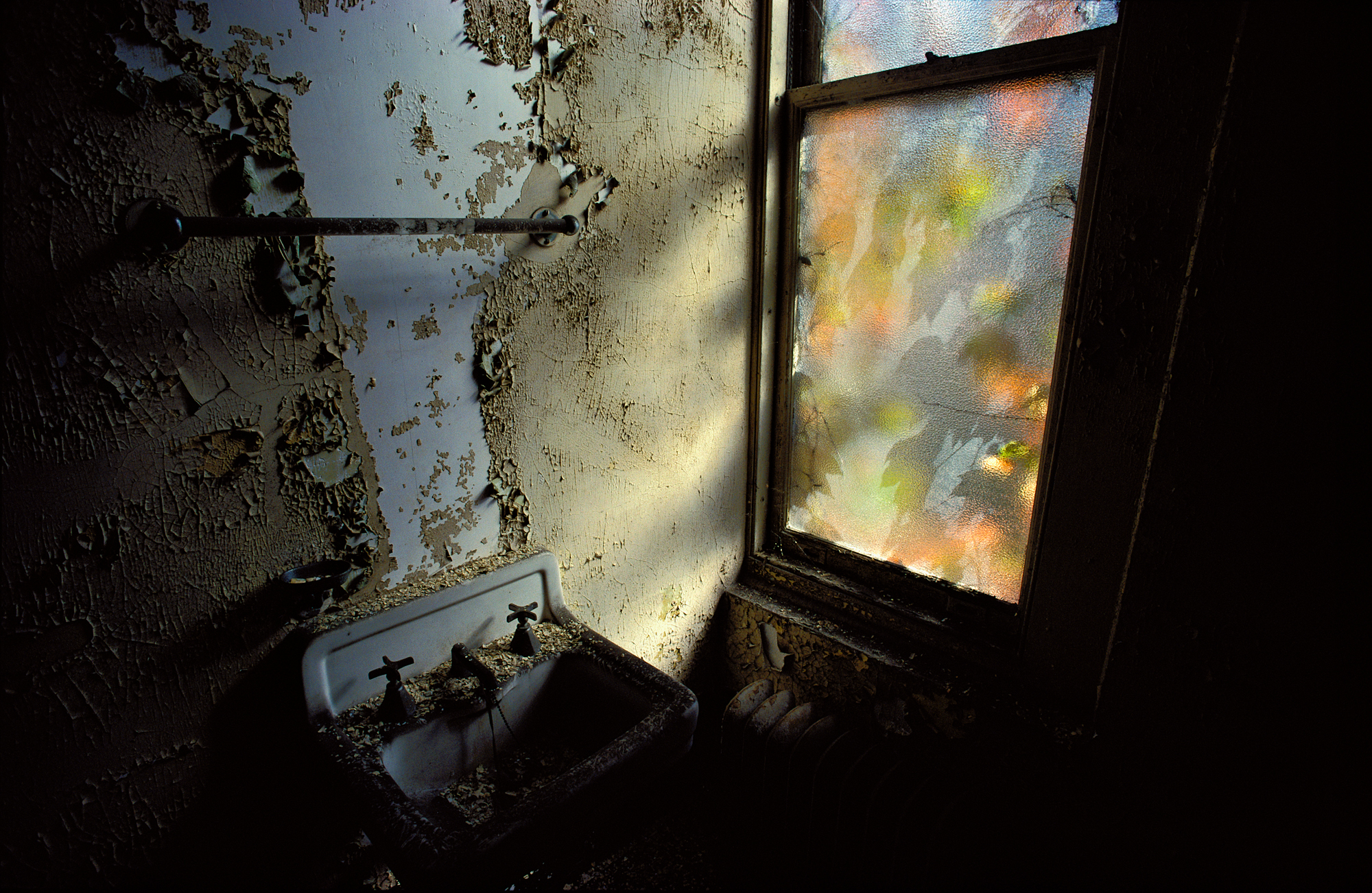
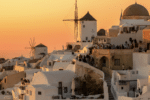
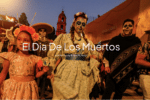
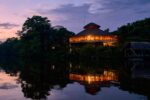

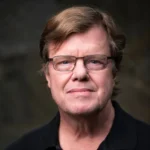


Nice work as usual.
best tips….
I *love* this blog. Thanks, Joe! 🙂
Good stuff, Joe. Your posts always leave me wanting to expand my collection of stuff.
Amazing results. So do you drag big lights with you all the time, just in case?
Pretty cool tips Joe! Love the shot of the lighting setup. Thanks for this post and keep up the amazing work.
When was it that you were at Villanova? Have you ever done any shoots at University of Penn?
Joe. What? No ticks!? No running around in gardens?? What the…great job making a boring area full of light and life!
You don’t seem crotchety enough to shoot only available light.
I saw a video going over how to light hotel resort rooms on the strobist blog, very similar to this but I do like the addition of a human subject. Great stuff!
I loved reading about the way you handled this situation! I recently shot a conference in a room like this, and it was a huge learning experience for me. Maybe some of your readers will find it helpful too: http://stephenelliot.com/2009/06/26/a-shooting-at-the-newseum/
Thanks so much for not only inspiring us with your photographs, but also giving us a behind-the-scenes glimpse into your work! It’s much appreciated!
GREAT work Joe!
I got so much respect to your technical skill!
And by the way 14-24 is SHARP!
Damn. You should write a book on this stuff… 🙂
Thanks Joe for the breakdown and the ideas.
Dermot
Ireland.
joe! joe joe joe. you are so consistently excellent it hurts. in a good way.
i love the small flash idea but i gotta say, you’re not exactly embracing small and portable… small flash for me means packing light — tiny stands, justin clamps, stoffen diffusers, a sheet of silk, a reflector disk, diffuser disk, a compact umbrella or two, some A-clamps, some tape, some itty bitty gels… some radio slaves, maybe 4 canon flashes… but YOU my friend, you are putting a small flash on a C stand — your poor (well paid & lucky to work for you) assistant… i couldn’t have done that shot with the 2400WS bare head — because i’m using little itty bitty lights — and that does certainly provide a great solution in that space…
anyhow JOE joe joe joe
keep it coming.
a loyal fan
Good post! Interesting and also helpfull 🙂
Wow, great tips, great outcomes.
Joe, Great quick tutorial on how to shoot a large room with a simple light setup! Thanks for sharing!
D-
Joe, you are the only person in the world that could just throw hard lights anywhere and make a masterpiece! You da man!
stepped on the warm pedal… hehehe 🙂
I wasn’t aware Joe McNally was *allowed* to shoot available light . . .
Out of curiosity, what would you have done if the room was smaller? I was trying to light a smaller room and couldn’t position the light in a way that the left side didn’t appear significantly hotter/brighter than the right. Thanks in advance.
Joe,
My alma mater never looked so good! A great school deserves your great images.
Great post and some very useful info. I like the last two shots posted a lot.
Great lesson for me, thanks Joe
woah Joe! your lighting rocks! i was faced with a much less complicated situation recently. i knew i could have done better. thanks for the tips. now, i know how i will do it better next time! hope to see you in South East Asia one day. cheers!
Won’t You make a workshop in Poland, Germany or my homeland Switzerland? 😉 I’ll help You to arrange everything!
I would be the first on the registration list. Most of my commercial CLS lighted pictures would never been shot without the tips i gathered from Your movies, books and this blog.
Joe – BIG RESPECT and thx for sharing Your knowledge!
Greets!
Good stuff Joe, as usual.
I love seeing your process in these blog posts, Joe. This one was particularly interesting to me, as I do a lot of architectural work, not usually with people in it, if I can help it though! Nice work, as always, Cindy
You were here in Philly!!?? I literally work about two blocks away!! I would have loved to see you set this up. Darn.
Great job!!!
Max
Here I was thinking right away that there was going to be a huge 100ft light stand outside with nine SB-900s mounted on it and sandbagged to all hell to mock the sunlight. Nope, even simpler setup. Nice light, Joe. And as always, very inspiring.
Hi Joe, great stuff as always! Was that 1 full cut of CTO or did you use more?
Thanks!
great post as usual…I’d like to believe it is okay for us faithful strobists to have quick affairs with mother nature’s natural light!
Why did you make the big light so warm and so hard? I understand needing to fill the space, but nothing in the rest of the image (inside or outside) makes sense with such orange light. If it was late afternoon and the shadows were lengthening outside, then it would have worked, but to me it just jars with the outside light.
Yo…
Would a polarizer be helpful on the last shot?
As a fellow educator, I share your sediment about how there are no secrets. A lot of respect and giving others the chance to learn. Because of that, I plug you as much as I can to the kids of my high school photo club.
Thanks for showing us some more inspiration. It makes me want to grab my camera.
Peace.
thanks for the post, interesting as everyone of yours. Lighting can be simple if you know how !
Joe great write up, but I got one word for ya..HDR!
No power packs, no taping no worries just 3-5 shots and some PP time on the computer. Great shots as always!
Nice tutorial about a hand-made sun
Hey Joe,
First of all a big THANK YOU for blogging so often considering the busy schedule with all those seminars. I’ve just finished watching the One Light video on Kelby Training and it’s really the first time I see you in working in tough conditions . Rainy woodlands, muddy banks, you name it. It’s so amazing how you could take that bad location and turn it into something usable.Had a really really good laugh especially when I learned that light “marinates” into daylight while traveling across distances. Anyway, it was an attitude lesson for all of us, and that is not taught very often these days.
You are allowed to get “crotchety” if you have spent your life hauling anvil or pelican cases around the world on annual report shoots. The weight limit on most airlines use to be 75 pounds and many of us were believers in the “bring everything in the studio, just in case”mindset.
Being able to “see” available light is a important as making the light believable. Joe is the master of seeing the possibilities and making it happen.
Great blog! I would have been lost if I had to try to get that picture. I need to get out of the woods occasionally. 🙂
Great lighting doesn’t have to be complicated and here you’ve shown us just that. Presumably, you’re using the Speedlite to trigger the mains light?
Thanks for continuing to share your wealth of knowledge, wisdom and humour.
Great, very informative post. Regarding the warmth/coloring of light, I’ve decided there’s no arguing about how subjective it is. I’m very much a “warm” light kind of person, to the point some people have told me I need to white balance my photos. As long as my subjects don’t look orange, and everyone who matters likes the result, I’d say go for whatever makes you feel good!
Chris
Love the final shot the most, but the interior is dramatic with the big light firing on all cylinders and creating those great shadows.
Thanks for posting
Great post Joe, I love difficult lighting situations (before the natural light scenario I mean). It’s always a lovely challenge trying to make flash look completely natural.
Cheers H.
@Howard : HDR defeats, in my opinion, the principle of “sculpting” with light. You have zero control over it and have to use, well, whatever is available. In other words, saying “go for HDR”, to me, is just another way of saying “go for available light”. It’d be nice to see examples of your own where an HDR shot was able to mimic a lighting setup, AND be done in the same – if not less – amount of time and stress. I have a feeling my tendinitis has already made its opinion on the subject (specially one involving post-processing). Just saying. 😉
@Joe : Well done. Keep ’em coming numnuts!
Albert (Montreal, Quebec)
Joe you SUCK!!! I HATE YOU so much. How in the hell do you make it look so easy. I now have to go buy some Elinchrom 2400’s. You are the worst, most dispicable as they come.
Great Job as usual, I still hate you, maybe as much as Hobby hates you.
Wow. That’s amazing! The light really makes a difference!
Deine Meinung kann ich nicht teilen.
Also visit my page … Damen Hosen
Great post – thanks
Pi?kne brawo
light is everything!
Perfect!
Thank you for a lot of interesting stuff!
Wow, thats great
great job I like this foto !!
I really like those photos!
Perfect job
Helpful info-thanks
Great job
Nice work! Keep it up!
pretty, warm light. Well done!
For me big light is always better!
Great tips! Thx!